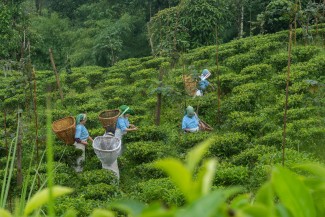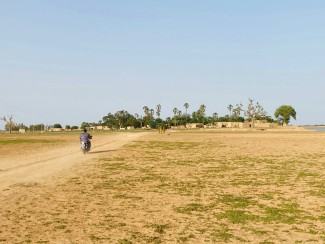The new beekeeping site in Ankesha near Lake Tana in Ethiopia is nestled in a verdant field amid a variety of plants that attract honeybees.
And attracted they were, with swarms buzzing in and out of the new, wooden hives painted in stark yellow.
This experiment in the village of Boya with 18 locals is aiming to help them develop an extra income source by leveraging the country’s long beekeeping tradition. In fact, Ethiopia produces the most honey and beeswax of any African country, with the majority used locally for the honey wine known as tej, as well as for candles used in church services.
But there are other prospects for honey that could help rural people like the ones in Ethiopia’s fertile north. Global demand for honey is increasing, and the country has space to develop an export product that meets international standards and lures consumers with distinguished flavours.
“Ethiopia has huge potential in honey if we increase our capacity in terms of some value addition of the honey products and identifying new markets. In terms of capacity in Africa, I think we are the leading country, so we can develop this as a new area to get export earnings,” said Mesgenu Arga Moach, State Minister of Ethiopia’s Ministry of Trade and Industry.
He added, “Ethiopian honey is very high in quality but meeting the international market standards is very important, and in terms of building the capacity this is important.”
Abebe Jenberie Wubie, PhD, of the International Centre of Insect Physiology and Ecology (ICIPE) is managing the work in eight districts with more than 2,000 individuals, training people in beekeeping techniques, providing starter kits in collaboration with another ICIPE project, and advising on plantings near apiaries and overall colony management.
During a walk through the fields in Boya, he pointed out the various plant varieties that were now growing in the apiary field.
“This is pigeon pea, and brassica, and potato and onion. Bees are drawn to them. Part of this work is helping new beekeepers know what to plant,” he said.
The group of 18 were given two hives each to maintain, with each hive potentially yielding 35 kilograms of honey per harvest, Wubie said.
“The options for rural people’s incomes are limited, and honey has so much potential and ability to support jobless youth,” he said.
So far, 2,450 people have been taught how to manage honeybee colonies and in what species of plants are preferred for bee foraging, and 186 have been trained in pollination and how to manage when hives aren’t active.
Agumas Asema, one of the trainees and newly minted manager of two hives, said he is hoping to make more money following his first honey harvest.
“I don’t own any land, I don’t have a major occupation,” Asema said. “I make money by growing on other people’s land and sharing the proceeds.”
He noted that following the training he can now identify the queen bee from the worker bees, and now his new group of fellow beekeepers can get advice and information from an agriculture extension officer and trainers.
“We believe jobless rural youths will be supported and drawn from poverty using beekeeping and its associated sideline activities as the key. This way, Ethiopian honey and other hive products will get a bigger chance to penetrate into world trade, and reach global consumers who are seeking genuine and natural products,” Wubie said.
If you would like to reuse any material published here, please let us know by sending an email to EIF Communications: eifcommunications@wto.org.



